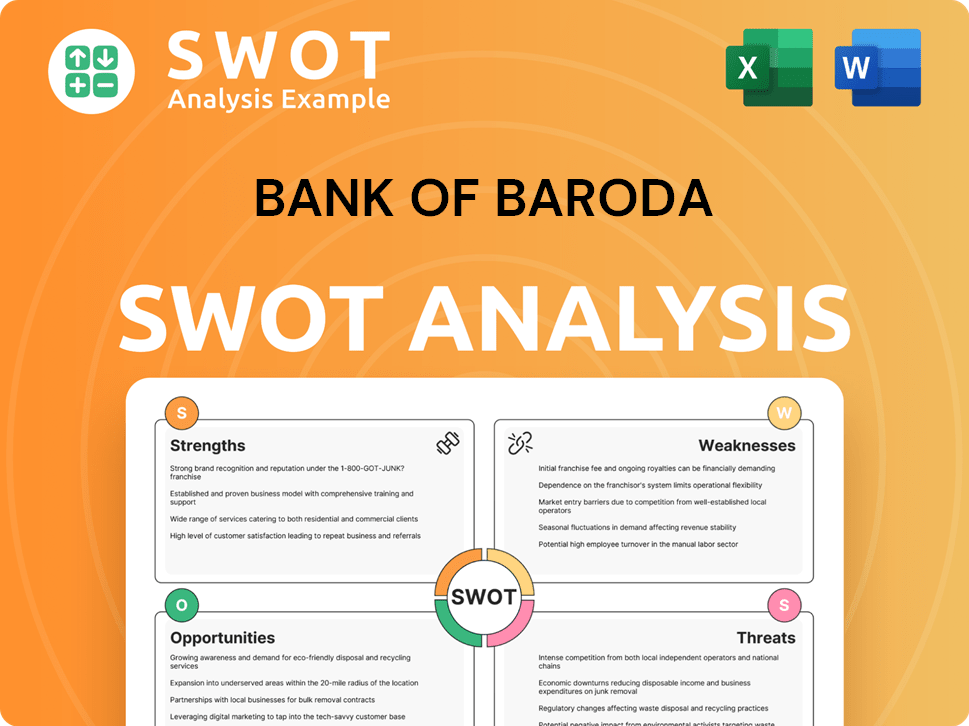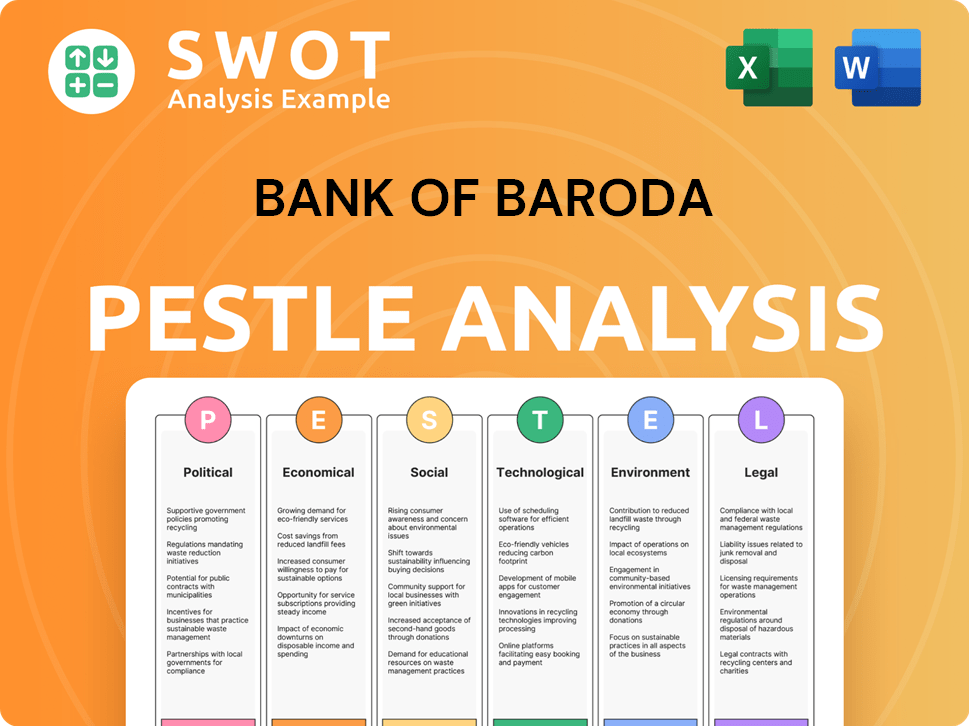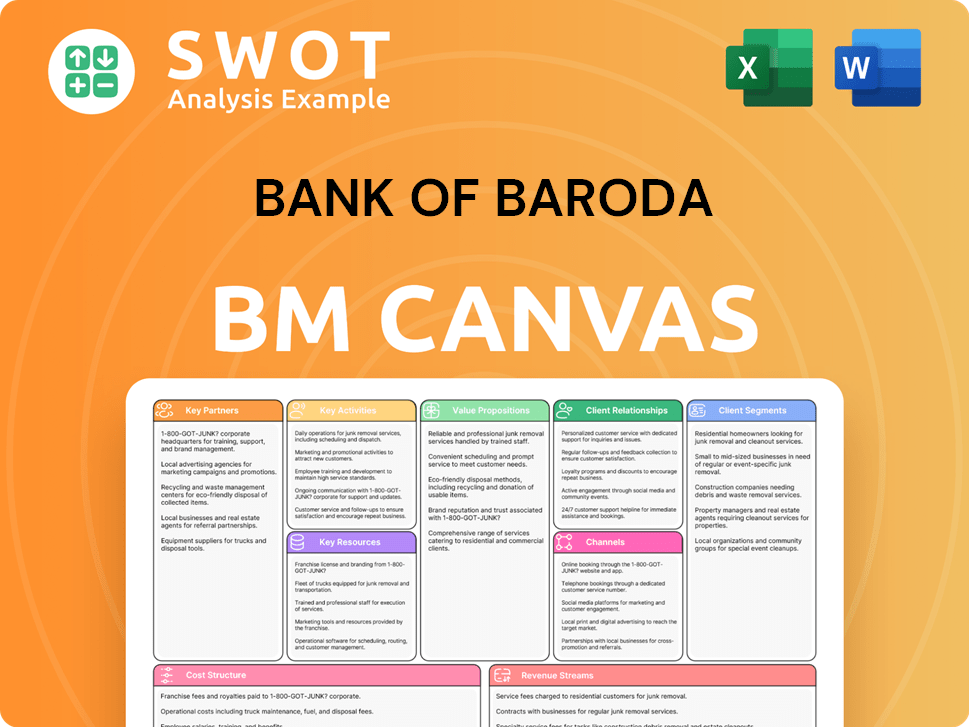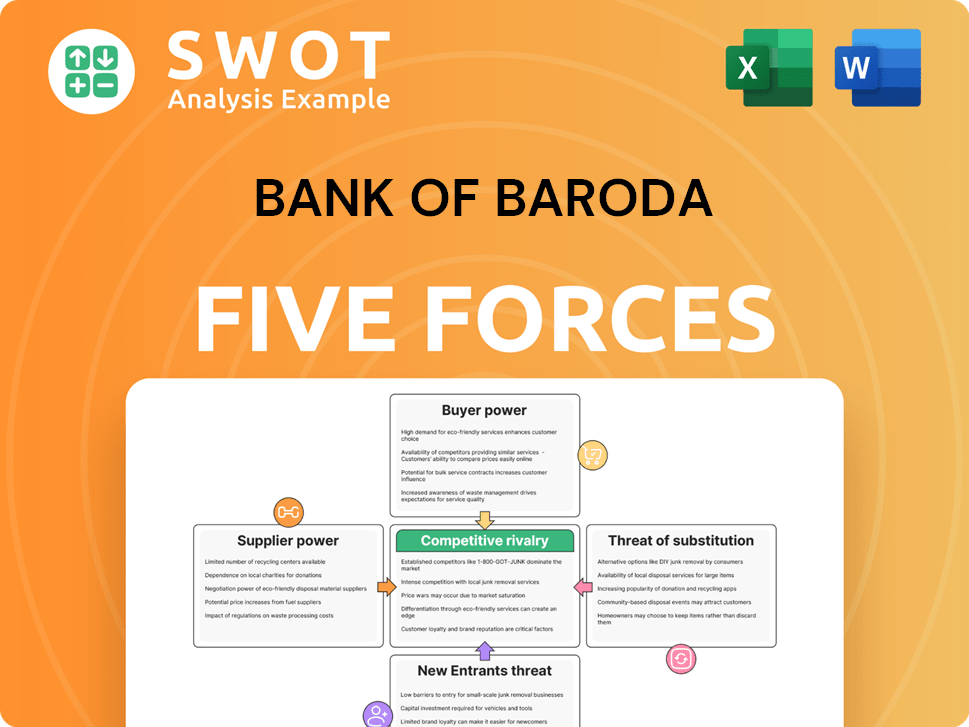Bank of Baroda Bundle
Who Really Owns Bank of Baroda?
Understanding a company's ownership is crucial for investors and strategists alike. It dictates the direction and priorities of the business, impacting everything from financial performance to long-term strategy. Unraveling the Bank of Baroda SWOT Analysis can provide deeper insights, but first, let's explore who truly controls this banking giant.

This exploration into Bank of Baroda's ownership will reveal the evolution of its shareholding, from its inception to its current status as a major player in the Indian banking sector. We'll examine the influence of the Indian government, institutional investors, and public shareholders, shedding light on the bank's history and the strategic implications of its ownership structure. Discover the key players in the Bank of Baroda ownership landscape and understand how they shape its future.
Who Founded Bank of Baroda?
The origins of Bank of Baroda, a significant player in the Indian banking sector, trace back to its establishment on July 20, 1908. The institution was founded in the princely state of Baroda by Maharaja Sir Sayajirao Gaekwad III. His vision was to create a financial institution that would serve the state's economic needs.
Initially, the bank operated as a privately-owned entity under the patronage of the Maharaja. This early ownership structure provided the foundation for the bank's growth and its ability to establish a strong presence, even before India's independence. The Maharaja's foresight was instrumental in shaping the bank's initial direction and its commitment to fostering financial development.
Maharaja Sayajirao Gaekwad III believed that the bank would be a 'beneficial agency for lending, transmission and deposit of money, a powerful factor in the development of art, industries and commerce of the state and also of adjoining territories.' While specific details regarding early equity splits or shareholding percentages are not widely available, the bank's initial capital and direction were firmly rooted in the Maharaja's support.
The initial ownership of Bank of Baroda was centered around the Maharaja of Baroda. This private ownership model allowed the bank to establish a strong presence and build banking relationships. The Target Market of Bank of Baroda includes a wide range of customers, from individuals to large corporations.
- The bank's early years were marked by private ownership under the Maharaja.
- The Maharaja's vision included supporting the development of art, industries, and commerce.
- The bank's initial capital and direction were provided by the Maharaja.
- The early ownership structure enabled the bank to establish a strong national presence.
Bank of Baroda SWOT Analysis
- Complete SWOT Breakdown
- Fully Customizable
- Editable in Excel & Word
- Professional Formatting
- Investor-Ready Format

How Has Bank of Baroda’s Ownership Changed Over Time?
The evolution of Bank of Baroda's ownership reflects significant shifts in its operational and strategic direction. Initially a private entity under the Maharaja of Baroda, the bank's trajectory changed dramatically on July 19, 1969, when the Government of India nationalized it, along with other major commercial banks. This transition placed Bank of Baroda under government control, transforming it into a public sector undertaking focused on profit generation.
A landmark event in the bank's recent history was the merger with Dena Bank and Vijaya Bank, which became effective on April 1, 2019. This merger, approved by the Union Cabinet on January 2, 2019, created the third-largest lender in India. The merger significantly impacted the bank's strategy and governance, aligning it more closely with national financial objectives while managing a diverse shareholder base.
| Shareholder Category | Stake as of March 31, 2025 | Stake as of March 2024 |
|---|---|---|
| Government of India | 63.97% | Not Available |
| Foreign Institutional Investors (FIIs) | 8.98% | Not Available |
| Mutual Funds | 9.17% | Not Available |
| Domestic Institutional Investors (DIIs) | Not Available | 17.96% |
| Insurance Companies | 7.52% | Not Available |
| Individual Investors | Not Available | 7.76% |
As of March 2025, the Government of India remains the majority shareholder of Bank of Baroda, holding a significant 63.97% stake. This substantial ownership highlights the government's direct influence on the bank's strategic decisions and regulatory compliance. Beyond the government, the ownership is diversified among various institutional and individual investors. Foreign Institutional Investors (FIIs) hold 8.98% of the shares as of March 2025. Mutual Funds collectively hold 9.17% of the shares as of March 2025. Domestic Institutional Investors (DIIs) collectively held 17.96% as of March 2024. Insurance companies hold 7.52% as of March 2025. Individual investors held approximately 7.76% as of March 2024. For further insights into the bank's growth trajectory, consider exploring the Growth Strategy of Bank of Baroda.
The ownership structure of Bank of Baroda is primarily influenced by the Government of India, which holds a significant majority stake.
- The government's ownership ensures the bank aligns with national financial objectives.
- Foreign Institutional Investors and Mutual Funds are also key shareholders.
- The merger with Dena Bank and Vijaya Bank expanded the bank's reach and influence.
- Understanding the shareholding pattern is crucial for investors and stakeholders.
Bank of Baroda PESTLE Analysis
- Covers All 6 PESTLE Categories
- No Research Needed – Save Hours of Work
- Built by Experts, Trusted by Consultants
- Instant Download, Ready to Use
- 100% Editable, Fully Customizable

Who Sits on Bank of Baroda’s Board?
The Board of Directors of Bank of Baroda plays a crucial role in the bank's governance, operating under the influence of its majority owner, the Government of India. As of the latest available information, Hasmukh Adhia serves as the Non-Executive Chairman, and Debadatta Chand is the Managing Director & CEO. Other key members include Executive Directors such as Ajay K Khurana and Joydeep Dutta Roy, and Shareholder Directors like Soundara Kumar, Srinivasan Sridhar, and Alok Vajpeyi, along with other Non-Official Directors. This structure reflects the bank's status as a public sector undertaking.
The board's activities are central to the bank's strategic direction. For example, in July 2024, the board approved a capital raising plan for FY25, involving Additional Tier 1 and Tier 2 Debt Capital Instruments to bolster its capital base. More recently, on May 6, 2025, the board approved the audited financial results for the quarter and year ended March 31, 2025, and recommended a dividend of ₹8.35 per equity share for FY2024-25. These actions highlight the board's continuous involvement in key financial and strategic decisions, reflecting its role in shaping the bank's future under the existing ownership structure.
| Board Member | Position | Affiliation |
|---|---|---|
| Hasmukh Adhia | Non-Executive Chairman | N/A |
| Debadatta Chand | Managing Director & CEO | N/A |
| Ajay K Khurana | Executive Director | N/A |
| Joydeep Dutta Roy | Executive Director | N/A |
| Soundara Kumar | Shareholder Director | N/A |
| Srinivasan Sridhar | Shareholder Director | N/A |
| Alok Vajpeyi | Shareholder Director | N/A |
The voting structure at Bank of Baroda generally follows a one-share-one-vote principle for its equity shares. However, the Government of India's substantial stake, holding 63.97% as of March 31, 2025, provides it with significant control and voting power. This majority ownership provides stability and implies potential government support, but it also means that government policies and directives directly impact the bank's strategies and compliance. Further insights into the bank's operations can be found in the Marketing Strategy of Bank of Baroda.
The Indian government is the primary owner of Bank of Baroda.
- The Government of India holds a majority stake, ensuring significant control.
- The board actively makes strategic decisions, including capital raising and dividend approvals.
- The ownership structure influences the bank's operations and strategic direction.
- The bank is a public sector undertaking (PSU).
Bank of Baroda Business Model Canvas
- Complete 9-Block Business Model Canvas
- Effortlessly Communicate Your Business Strategy
- Investor-Ready BMC Format
- 100% Editable and Customizable
- Clear and Structured Layout

What Recent Changes Have Shaped Bank of Baroda’s Ownership Landscape?
Over the past few years, the ownership structure of Bank of Baroda has remained largely consistent, with the Government of India holding a significant stake. As of March 31, 2025, the government's promoter holding stood at 63.97%, reflecting a stable ownership foundation. This stability is crucial for the bank's strategic direction and operational continuity.
Institutional investors have shown varied movements. Foreign Institutional Investors (FIIs) increased their holdings slightly, while Mutual Funds decreased theirs. Notably, Life Insurance Corporation (LIC) increased its stake, indicating confidence in the bank's long-term prospects. These shifts highlight the dynamic nature of the Bank of Baroda ownership landscape, influenced by market conditions and investor sentiment.
| Shareholder Category | March 2024 | March 2025 |
|---|---|---|
| Government of India | 63.97% | 63.97% |
| FIIs | 8.90% | 8.98% |
| Mutual Funds | 9.58% | 9.17% |
| LIC | 5.03% (Nov 2023) | 7.05% (April 2025) |
The bank is actively raising capital to support its growth plans and meet regulatory requirements. In February 2025, the board approved raising up to ₹8,500 crore through a Qualified Institutional Placement (QIP). This capital-raising strategy, along with improvements in asset quality, positions the bank for future expansion. For more insights, you can explore the Competitors Landscape of Bank of Baroda.
The Government of India maintains the largest stake, ensuring stability and strategic alignment.
FIIs and LIC have shown increased interest, while mutual funds have adjusted their holdings.
Bank of Baroda is actively raising capital via QIPs to support growth and meet regulatory needs.
The bank aims to double its balance sheet and increase market share, supported by strategic initiatives.
Bank of Baroda Porter's Five Forces Analysis
- Covers All 5 Competitive Forces in Detail
- Structured for Consultants, Students, and Founders
- 100% Editable in Microsoft Word & Excel
- Instant Digital Download – Use Immediately
- Compatible with Mac & PC – Fully Unlocked

Related Blogs
- What are Mission Vision & Core Values of Bank of Baroda Company?
- What is Competitive Landscape of Bank of Baroda Company?
- What is Growth Strategy and Future Prospects of Bank of Baroda Company?
- How Does Bank of Baroda Company Work?
- What is Sales and Marketing Strategy of Bank of Baroda Company?
- What is Brief History of Bank of Baroda Company?
- What is Customer Demographics and Target Market of Bank of Baroda Company?
Disclaimer
All information, articles, and product details provided on this website are for general informational and educational purposes only. We do not claim any ownership over, nor do we intend to infringe upon, any trademarks, copyrights, logos, brand names, or other intellectual property mentioned or depicted on this site. Such intellectual property remains the property of its respective owners, and any references here are made solely for identification or informational purposes, without implying any affiliation, endorsement, or partnership.
We make no representations or warranties, express or implied, regarding the accuracy, completeness, or suitability of any content or products presented. Nothing on this website should be construed as legal, tax, investment, financial, medical, or other professional advice. In addition, no part of this site—including articles or product references—constitutes a solicitation, recommendation, endorsement, advertisement, or offer to buy or sell any securities, franchises, or other financial instruments, particularly in jurisdictions where such activity would be unlawful.
All content is of a general nature and may not address the specific circumstances of any individual or entity. It is not a substitute for professional advice or services. Any actions you take based on the information provided here are strictly at your own risk. You accept full responsibility for any decisions or outcomes arising from your use of this website and agree to release us from any liability in connection with your use of, or reliance upon, the content or products found herein.